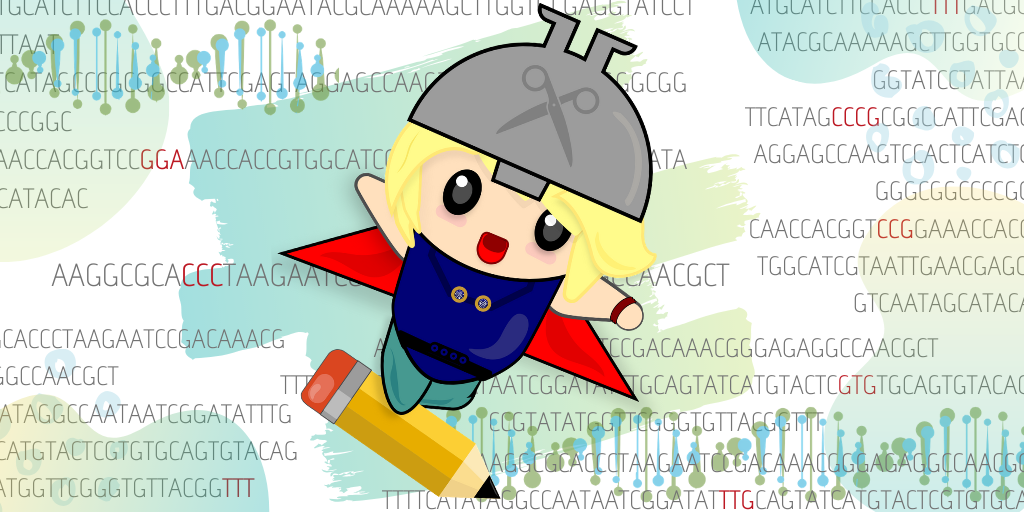
This little gene editing superhero was created by Tara Fernandez for Signalsblog.ca. H/T to Fyodor Urnov, University of California, Berkeley, for the Avengers comment that was the inspiration.
In a dark corner of the nucleus, a mutation lurks, up to no good. It stealthily swaps a DNA base – an A to a T – gleefully awaiting the catastrophic consequences on the encoded protein.
A brave CRISPR molecule enters the nucleus and armed with its razor sharp enzyme, Cas9, is determined to rid this genome of unwanted errors. Its other secret weapon, guide RNA, acts like a compass, directing CRISPR directly to the afflicted gene.
CRISPR launches a full-blown attack, hurling Cas9 at the faulty DNA strands in the hopes the cell patches up the mutations with the correct replacement sequence. As the dust settles, CRISPR realizes it has missed the mark – the cleaved section of the double helix was repaired incorrectly. The nefarious mutation wins this time.
All hope is not lost, however. A new superhero emerges, designed to pick up CRISPR’s slack and obliterate DNA glitches for good. Enter the prime editor. In a recent article published in Nature, inventors Andrew Anzalone and David Liu describe this game-changing gene editing innovation, pinning bold predictions on how this development can substantially surpass CRISPR’s mutation-busting abilities.
The team from Harvard University claims that prime editing has the capacity to mend a massive 89 percent of all the genetic mutations responsible for heritable human diseases.
What superpowers does prime editing hold that differentiate it from its predecessor?
Most of all, this new-and-improved system works with unrivalled precision and flexibility.
The standard approach of Cas9 is to snip both strands of DNA, relying completely on the cell’s notoriously inconsistent repair systems to reassemble them. This process is prone to errors, with the cell’s DNA repair machinery often inadvertently inserting or removing DNA bases at the cut site.
In prime editing, Cas9 gets a makeover, now only making one nick to a single strand to reduce the risk of mistakes. Directed by a guide RNA sequence, prime editing no longer relies on the cell’s repair system, but uses its own enzyme, reverse transcriptase, to make the necessary modifications.
What bolsters its accuracy are additional built-in safeguards, such as the primer feature on the guide RNA, which must precisely pair with the target DNA site in order to proceed with the edit. This means fewer mistakes and, considering all changes are permanent ones, is paramount for potentially using prime editing therapeutically.
First generation DNA editors were extremely limited in their capabilities, only able to tackle four variations of basic, single DNA base substitutions: A-to-T, C-to-G and vice versa.
Prime editing’s superior versatility makes it even more likely to triumph over more complicated genetic defects.
Anzalone and team demonstrated just how much prime editing has improved by successfully making more than 175 edits to a variety of complex mutations in human cells. Among these were very intricate gene repairs that CRISPR could never pull off – an insertion of a new sequence with 44 DNA bases and an 80 base long deletion.
Prime editors may have been shown to pack a punch, but they are still far from perfect. What’s holding them back? Their size. Compared to their counterparts, prime editing components are relatively huge, making transporting them into cells to amend genomes a gargantuan task. Conventional delivery mechanisms such as viral vectors or microinjections won’t cut it (no pun intended), leaving scientists having to go back to the drawing board to find alternatives.
A National Institutes of Health database lists over 75,000 DNA variants known to be responsible for human disease. While that’s a long list of bad guys for prime editors to take down, Liu and his team remain optimistic, having already forged a new company, Prime Medicine, to commercialize this innovation.
Despite some foreseeable challenges ahead, ongoing testing in more cell and disease models will reveal just how powerful of a superhero the prime editor could be.
(Ed: a quote in STAT from genetic engineer Fyodor Urnov, University of California, Berkeley, referring to genome-editing technologies as superheroes with different powers sparked the idea for this post and the creation of “Prime Editor,” the superhero. Thanks to author Tara Fernandez for enthusiastically embracing this idea and creating Prime Editor, Marvel’s newest superhero?)
Tara Fernandez
Latest posts by Tara Fernandez (see all)
- Unlocking stem cells’ full potential for treating multiple sclerosis – Highs, lows and future opportunities from OHRI’s MESEMS trial - January 13, 2022
- So you want to be a science communicator? Advice from a professional science writer - October 29, 2021
- New gene therapy shows promise, but is it enough to reverse aging? - August 25, 2021






Comments